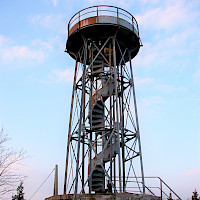Komáří hůrka (Mosquito Mountain, 807m) protrudes from the Erzgebirge ridge like a pimple and is therefore easily visible from all directions. On its top there is the Komáří vížka (Mosquito Tower), a very popular mountain hotel with a restaurant (and the charm of the 80s).
From here you have a magnificent panoramic view in all directions. To the north, you look over the hilly, gently sloping plateau of the Erzgebirge all the way to the Elbe Valley. To the south, the Erzgebirge slopes steeply, opening up a wide view of the extinct volcanic cones of the Bohemian Central Mountains. To the west, the view sweeps along the slightly curved ridge of the Ore Mountains to beyond the Keilberg (Klínovec). To the east, you can see Bohemian and Saxon Switzerland, the Lusatian Highlands and, with reasonably good visibility, Ještěd near Liberec and the Jizera Mountains. In very good visibility you can see as far as the Krkonoše Mountains.
Below Komáří hůrka lies the old mining town of Krupka (Graupen) with mining tradition from the 13th century. The mountain is therefore littered with pings (pits, holes). A very large pinge is located right next to the mosquito tower. It is under nature protection. In connection with mining, a stone bell tower was erected on the summit in 1568 to announce the beginning and end of the shift. This was integrated into the tavern built in 1857.
A chairlift was built from Bohosudov to the summit in 1950-1952, at that time the longest in the world at 2348 m, and today still the longest without an intermediate station in the Czech Republic. It overcomes a height difference of 482 m.
The name Mosquito Tower or Mosquito Mountain is said to come from an old legend (according to Wikipedia). According to it, when a crafty cattle thief tried to steal the only cow from an old lady, she cursed him: "You shall be bitten by mosquitoes before you reach the top of the mountain!" And indeed, a huge swarm of mosquitoes appeared and killed the thief.
The mosquito tower is a very popular destination for both hiking and winter sports.
Below the summit is the chapel of St. Wolfgang. Unfortunately, this is only open from May to September.
















